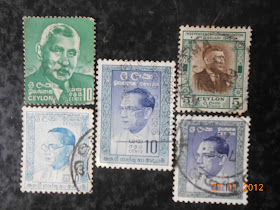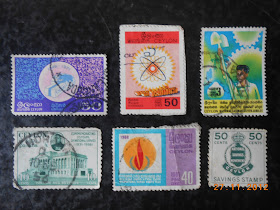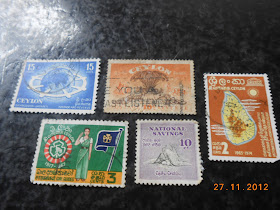Welcome to World of Ceylon Stamps
The first stamps for Ceylon were issued on 1 April 1857.The stamp features a portrait of Queen Victoria and is brown in colour. It is a 6 pence value used to send a half ounce letter from Ceylon to England. Eight more stamps were issued in year 1857, all featuring the portrait of Queen Victoria. One of the 5 stamps that were issued on 23 April 1859 is considered to be the most valuable stamp in Sri Lanka: it is a 4 pence with a dark pink colour known as the 'Dull Rose'.
History of Stamps
Sri Lanka Post has a long history of 209 years, dating back to 1798, when the colonial Dutch rulers started five post offices in the Maritime Districts under their control. In 1799, they published the first postal regulations and postage rates. The Dutch East India Company operated the Postal service, which was not meant for the public but for official use.
The British took control of the country in 1815. The first Postmaster General of Ceylon was A. Kennedy, an Army Officer. However, there were other Post Master Generals since 1815, when E. Bletterman was the PMG for the whole island. Mr. Lewis Sansoni succeeded Bletterman as the second Postmaster General in 1817. The third Postmaster General was Major G. Stewart, who extended the postal services to major towns in the country. They re-organised the postal service and others eventually established a permanent Post Office in Colombo in 1882.
Sri Lanka though a small island 60,000 sq. km in extent, boasts of a heritage dating back several millions of years. Archaeologists identify the history of ancient primitive inhabitants as the Pre-historic era. They believe that beyond the historically recorded period of self sufficiency, there lived in an unrecorded period of 125,000 years ago people who possessed the technical skills of making structures by using stones and fragments of bones.
To illustrate the pre-historic era of ancient Sri Lanka, the Philatelic Bureau recently released a set of stamps thereby marking a new chapter in the history of Sri Lankan stamps. The stamp bulletin issued with this Special Issue gives a wealth of information on the early history. The Bulletin describes how on the basis of archaeological findings and types of physical remnants like bones and materials used by pre-historic man, archaeologists have categorized this primitive period into three divisions.
The first is the Paleolithic Age - the period of the most ancient or primitive man. Stone tools belonging to the Lower Paleolithic period i.e beyond 250,000 years have been discovered from earth deposits beneath the earth layers which were marked as 125,000 years old. These tools are deemed to have belonged to the homo habilis man, whose history is not very clear.
Tools belonging to the Middle Paleolithic period have been found from earth deposits in Ratnapura and its surrounding areas as well as the coastal areas. They were discovered at Galkanda, Ussangoda and Bundala in the Hambantota district and at Iranamadu in the north. These have been used by man known as homo erectus. The last division is Upper Paleolithic but strangely, no tools or implements used by man during this time have been found.
The Mesolithic Age is the period dating back 40,000 years and beyond when small sized tools and implements had been used by homo sepeane sepunane or the prag modern man. There is evidence that he lived all over the island. These human species have lived in the wet zone in caves in places like Batadombalena in Kuruwita, Belilena in Kitulgala, Fahiyangalalena near Agalawatte and Asmadalagala in Avissawella. In the dry zone there is evidence of caves in Sigiriya, Aligala and Potaana. Even in the coastal region, evidence has been found in places like Pallemalla.
Evidence relating to the Neolithic Age has been scarce except those found at excavations at a few places like the Dorawaka mountain.
The horizontal format stamps are distinct in that each design has two elements. On the right hand side of each stamp is a close-up of a feature relating to the era depicted in the stamp. The Rs. 5 stamp depicts the early Stone Age. Minihagalkanda in the southern coastal belt around Panama had been a human habitat possibly 300,000 years ago. On the right are stone tools said to be at least 125,000 years old, according to the researchers.
Special types of stone have been used in turning out these stone tools to be used in hunting and to process meat. The Rs. 20 stamp shows some animals in Sri Lanka that are now extinct. They are believed to have existed 125,000 years ago. The bone fragments of the rhinoceros and the hippopotamus found in the Ratnapura gem gravels are on the right. The Balangoda culture is depicted in the Rs. 25 stamp featuring Batadombalena in Kuruwita believed to be over 30,000 years old belonging to the late Stone Age. Humans are supposed to have lived there. The human skull seen on the right is from a cemetery in the Bellanbendipelessa. Several bones and skulls have been found during excavations in this region. These human remnants are at least 7,000 years old.
Pre-historic agriculture in the Horton Plains, a prominent agricultural centre of the new Paleolithic age is seen in the Rs. 30 stamp. Research has shown that barley and similar grains had been cultivated at the time. A barley pollen grain said to be 13,000 years old has been enlarged 30,000 times in the illustration on the right.
Of the four stamps, designed by Pulasthi Ediriweera, three are high value stamps and are for use for overseas mail. With postal rates going up, high value stamps are being issued frequently. The average stamp collector, of course, finds it too expensive when such stamps are released regularly.
-The End-

.jpg)






































